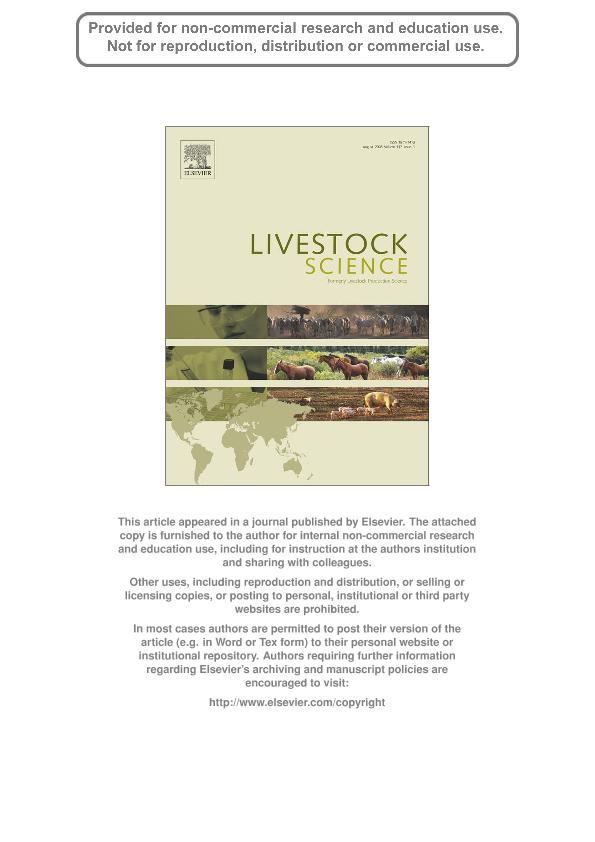Mostrar el registro sencillo del ítem
dc.contributor.author
Garrido, Lenin Ron
dc.contributor.author
Birchmeier, Ana Nélida

dc.contributor.author
Munilla Leguizamon, Sebastian

dc.contributor.author
Cantet, Rodolfo Juan Carlos

dc.date.available
2021-05-07T05:01:18Z
dc.date.issued
2008-08
dc.identifier.citation
Garrido, Lenin Ron; Birchmeier, Ana Nélida; Munilla Leguizamon, Sebastian; Cantet, Rodolfo Juan Carlos; Estimation of effective population size using bivariate discrete distributions for modeling family size in beef cattle; Elsevier Science; Livestock Science; 117; 1; 8-2008; 43-51
dc.identifier.issn
1871-1413
dc.identifier.uri
http://hdl.handle.net/11336/131614
dc.description.abstract
Pedigree records of 72,808 animals (45,668 females and 27,140 males) from the genetic evaluation program of the Argentine Brangus Association were used to estimate effective number of founders (Nf), effective number of ancestors (Na), and effective population size under random mating (Ne) or selection (NeS), in order to assess genetic variability. The average level of completeness of the pedigree was low (0.17) and the average level of inbreeding (F) calculated from the pedigree was equal to 0.24%. Animals in the reference population were 21,662 calves born from 2001 to 2005. The estimated measures of variability were Nf = 765.7 and Na = 387.5. The numbers of ancestors responsible for 100%, 50%, or 20% of the genes in the reference group, were equal to 12,471, 273, and 22, respectively. Direct estimates of Ne and NeS were calculated using the variances and covariances of family sizes, i.e. male and female progeny numbers for bulls and cows. Estimates of the dispersion parameters were from the Bivariate Poisson model for the cows, and from the Generalized Bivariate Negative Binomial (GBIVARNB) distribution for the bulls. The latter probability mass function accounted for overdispersion, a characteristic present in the sampling distribution of family size of bulls. The estimated variances of male and female progeny and the covariance between them for the bulls were 5.70, 271.28, and 30.15, respectively, and 1.15, 2.10, and 1.06 for the cows. Generation intervals (in years) were: sires of bulls = 5.0, sires of cows = 5.7, dams of bulls = 4.4, and dams of cows = 5.2. The estimated Ne was 274, which corresponds to a rate of inbreeding (F) of 0.18%, whereas NeS = 125 and F = 0.40%. As a check of the proposed methodology, all analyses were also performed using the pedigree records of 10,483 Angus animals from a herd with an average level of completeness of 0.68. Using the GBIVARNB model for both bulls and cows the estimated Ne = 95.4, thus F = 0.5% in perfect agreement with the calculated average inbreeding from pedigree records. Under selection, NeS = 79.3 and F = 0.6%. The larger difference between estimated Ne and NeS in the Brangus was related to the smaller bull to cow ratio in the breed. Therefore, it seems desirable to continue monitoring the effective size of the Argentine Brangus to prevent problems of inbreeding and lack of variability in the future. © 2007 Elsevier B.V. All rights reserved.
dc.format
application/pdf
dc.language.iso
eng
dc.publisher
Elsevier Science

dc.rights
info:eu-repo/semantics/openAccess
dc.rights.uri
https://creativecommons.org/licenses/by-nc-sa/2.5/ar/
dc.subject
BIVARIATE DISCRETE DISTRIBUTIONS
dc.subject
BRANGUS
dc.subject
EFFECTIVE POPULATION SIZE
dc.subject
FAMILY SIZE
dc.subject
OVERDISPERSION
dc.subject
SELECTION
dc.subject.classification
Otras Producción Animal y Lechería

dc.subject.classification
Producción Animal y Lechería

dc.subject.classification
CIENCIAS AGRÍCOLAS

dc.title
Estimation of effective population size using bivariate discrete distributions for modeling family size in beef cattle
dc.type
info:eu-repo/semantics/article
dc.type
info:ar-repo/semantics/artículo
dc.type
info:eu-repo/semantics/publishedVersion
dc.date.updated
2021-04-28T21:41:00Z
dc.journal.volume
117
dc.journal.number
1
dc.journal.pagination
43-51
dc.journal.pais
Países Bajos

dc.journal.ciudad
Amsterdam
dc.description.fil
Fil: Garrido, Lenin Ron. Universidad de Las Fuerzas Armadas; Ecuador
dc.description.fil
Fil: Birchmeier, Ana Nélida. Universidad de Buenos Aires. Facultad de Agronomía. Departamento de Producción Animal. Cátedra de Mejoramiento Genético Animal; Argentina
dc.description.fil
Fil: Munilla Leguizamon, Sebastian. Universidad de Buenos Aires. Facultad de Agronomía. Departamento de Producción Animal. Cátedra de Mejoramiento Genético Animal; Argentina. Consejo Nacional de Investigaciones Científicas y Técnicas; Argentina
dc.description.fil
Fil: Cantet, Rodolfo Juan Carlos. Universidad de Buenos Aires. Facultad de Agronomía. Departamento de Producción Animal. Cátedra de Mejoramiento Genético Animal; Argentina. Consejo Nacional de Investigaciones Científicas y Técnicas; Argentina
dc.journal.title
Livestock Science

dc.relation.alternativeid
info:eu-repo/semantics/altIdentifier/url/https://www.sciencedirect.com/science/article/pii/S1871141307005380
dc.relation.alternativeid
info:eu-repo/semantics/altIdentifier/doi/https://doi.org/10.1016/j.livsci.2007.11.008
Archivos asociados
